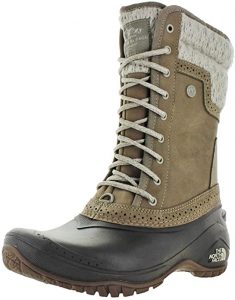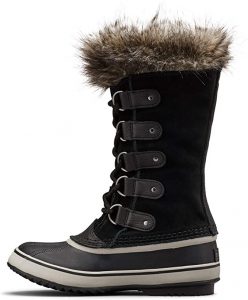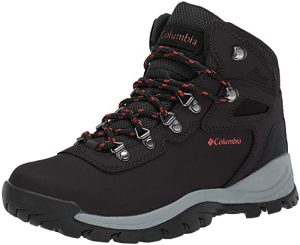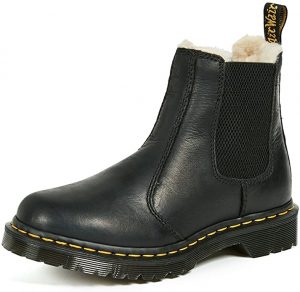As we women well know, the right winter boots can be hard to find. The stylish boots aren’t comfortable or warm. The comfortable and warm boots aren’t stylish. What’s a fashionable girl to do when the leaves drop and the weather turns cold?
These common problems inspired us to create this easy-to-understand guide to all things winter boots. We tracked down the best looking, warmest, most comfortable winter boots for your feet and your style.
The 6 factors we considered were outer materials, waterproofing, insulation, temperature ratings, height, and comfort. These features are key to finding the best cold-weather boots.
After reading this article, you will know what to look for in cold-weather boots as well as the best pairs on the market. If you still have questions, the questions and answers may clear it up for you. We guarantee you’ll find the best fashionable, functional pair of boots for your needs!
Our Pick of the Best Fashionable Winter Boots for Women
#1. Best Cold-Weather Winter Boots: Sorel Women’s Explorer Carnival
Sorel Women’s Explorer Carnival are sporty, cozy winter booties that come to the top of the ankle. There are 11 different styles to choose from and come with either faux fur or felt for extra warmth and fashion.
A nylon outer shell, rubber sole, and PU synthetic overlay create a trifecta of waterproofing. Rated to 10 degrees below zero, these Sorel’s are extremely warm in the winter weather. However, buy a half size up if you plan on wearing thick, warm socks.
Unlike some boots that must be unlaced or loosened, these Explorer’s are easy to put on and take off. They don’t rub against your toes or heels, making them good for everyday wear or weekend hikes in the snow.
Pros:
- Lightweight
- Do not need to be broken in
Cons:
- Fur trim stands away from bootie to allow snow inside
- Not very breathable
- Large tongue
#2. Best Affordable Winter Boots for Women: Columbia Women’s Ice Maiden II
The Ice Maiden II by Columbia is a true-to-size fit boot for multiple uses. You can wear them with snow pants or tuck your jeans inside. There are 11 different colors and at least one is guaranteed to fit any fashionista’s sense of style.
As with all Columbia boots, the sole is rubber and features Omni-Grip traction for safe winter walking. To keep your feet warm in temperatures down to -10 degrees Fahrenheit, the synthetic insulation is 200 grams. The outer boot is made from leather and suede for a waterproof finish.
In terms of shaft height, the top of the boot hits between ankle and mid-calf. There are an added fur collar and fur tongue lining for extra warmth and flair. The removable footbed is contoured to keep your toes from bunching up no matter where you’re walking.
Pros:
- Removable insoles
- Lightweight at 1.2 pounds
- Do not need to be broken in
Cons:
- More chunky than other boots on the list
- Hard footbed
#3. Best Tall Winter Boots: The North Face Shellista II
If you are searching for a tall, waterproof boot, look no further than The North Face Shellista II. There are 14 different colors and styles so you’re sure to find one that compliments your wardrobe.
The Shellista is a true multi-use shoe. This 12.5-inch tall boot can transition seamlessly from office to street, to trail. Meanwhile, the cushioned footbed and arch support keep your feet happy.
This North Face is second to none when it comes to waterproofing. The foot is covered in rubber, and the leather/mixed wool upper also sheds water. There is also TPR waterproof shell for additional weatherproofing.
The insulation is a 200-gram synthetic PrimaLoft Silver Eco, and there is extra cushioning around the ankle for comfort while walking. This keeps your feet and lower legs warm in temperatures down to the high teens. Be aware this shoe runs a half size small, so order up!
Pros:
- Lightweight at under 3 pounds
- 100% waterproof
- Laces allow a customizable fit
Cons:
- Could have better traction
- Too narrow for wide-sized feet
- Stiff – must be broken in
#4. Best Warm Stylish Winter Boots: Sorel Joan of Arctic
The Sorel Joan of Arctic is the most fashionable warm winter boot on this list with 31 stylish choices. This Sorel is great for everything from daily use to special winter walks in the woods. To get the full -25-degree Fahrenheit rating, pair these shoes with thick wool socks.
It has an 11.8-inch waterproof suede shaft to keep you dry, and 6mm thick felt insulation to keep you warm. If the insides do happen to get wet, the liner is removable for quick drying. The addition of this liner makes the shoe fit a half size too big, so order down.
The wraparound rubber comes up over the foot and serves the purpose of waterproofing and protecting your toes. The fur cuff prevents snow and other debris from entering the top of your boots, which tends to happen when cleaning your car or shoveling the sidewalk.
Pros:
- 100% waterproof with seam sealing
- Maneuverable – no need to break in
- High-quality material and construction
Cons:
- Expensive
- Heavier at over 3 pounds
- Could have better traction
#5. Best Snow Boots Lady Hiker Approved: Columbia Women’s Newton Ridge Plus
The Columbia Women’s Newton Ridge Plus is the best option if you plan to hike in the winter. They’re also great for walking to work or around town looking at Christmas lights. As a bonus, the Newton’s are affordable for ladies on a budget.
The outer material is leather, full-grain, and top quality. Paired with the rubber sole, this semi-sealed boot is water-resistant. Just don’t walk through a deep puddle! The soles are Columbia’s patented Omni-Grip and track just as well as the pricier Vibram soles.
This Columbia boot is more like a bootie: it is 5.25 inches tall from the supported arch. In terms of fit, the D-ring laces allow you to adjust the tightness. This allows you to wear thick socks in the summer and thin socks in the winter for year-round use.
Pros:
- Tough D-ring laces and clamshell grommets won’t break
- Lightweight at 2 pounds
- No break-in period
Cons:
- Not a lot of toe protection for rockier trails
- Little ankle support
- No additional insulation for cold days
#6. Best Winter Booties for Women: Dr. Martens Leonore Burnished Wyoming Fashion Boot
Dr. Martens Leonore Burnished Wyoming Fashion Boot is made from black leather with a sleek, uniform design. Despite the abbreviated name, these booties retain the traditional Doc Marten yellow stitching, heel loop, and grooved sides.
The lower and upper soles are welted together in customary Doc Marten fashion. This means they are sewn together and sealed with heat. The quality ensures you will be able to keep these scuff-resistant boots for many winters to come. These Doc’s run small, so buy a half size up.
This brand name is famous for its air-cushioning for all-day comfort, and the sole is slip-resistant for walks on icy sidewalks or slick floors. The shaft measures 5.5 inches tall and the insides are lined with faux fur for warmth down to zero degrees Fahrenheit.
Pros:
- Weighs less than 1 pound
- Precision fit
- Easy to dress up or down
Cons:
- Need to be broken in
- UK sizing
- Not made for wide feet
Female Winter Boots Buying Guide
As you read through our list, there may be some unfamiliar terms. Shoe technology is always progressing, and if you haven’t bought winter boots in a while it can be easy to get lost in the terminology.
Overall, there are 6 factors to understand when shopping for new boots to wear in the cold: outer materials, waterproofing, insulation, temperature rating, height, and comfort. In this buying guide, we will demystify any confusion.
Outer Materials
A boot’s outer material is important for both warmth and waterproofing.
- Nylon
Nylon is not made to slough off water. This problem is solved by a waterproof coating, such as the Sorel Women’s Explorer Carnival. Happily, nylon is breathable, so your feet and legs won’t sweat while you’re wearing your boots.
- Leather
Leather is waterproof and breathable, but it’s not as breathable as nylon. This material conforms to your feet for comfort and is known to last for years. Leather is more expensive than other materials, so view your leather boots as an investment.
- Suede
Suede is another quality material that will warm you this winter. It is breathable, lightweight, and conforms to your feet for an extremely comfortable cold-weather jaunt.
- Rubber
All of the boots on our list are made with a rubber sole. Rubber provides waterproofing and some traction. Also, companies building in extra grip through bumps and crevices on the sole. Columbia uses the very secure Omni-Grip technology for safety.
Conveniently, rubber is easy to clean. As long as the other outer material is waterproof, you can simply hose the dirt, gravel, and salt off your boots.
Waterproofing
While most of the boots on our list are waterproof, at least one is water-resistant. What are the differences, and do they matter?
- Waterproof
Waterproof shoes are made with materials, including sealed seams, designed to keep water out. This is especially important if you plan to wear your boots on longer walks or hikes in the snow and the rain. Some companies also treat their products with a waterproof spray.
Due to the use of waterproof materials, these boots tend to be heavier with a bulkier profile.
- Water-resistance
Water-resistance does exactly what you think it does: repel water. Although these materials do not keep water completely out, they do have some waterproofing abilities. These boots are perfect for light snow, light rain, and frigid days.
Water-resistant shoes are typically lighter with a thinner profile.
Insulation
The type of insulation helps determine the warmth of the boots. The greater the number, the warmer the shoe. For cold temperatures, you will want 200 grams of insulation or higher.
- Thinsulate
This material is a synthetic fiber finer than down or polyester. With Thinsulate, you get the same amount of heat retention for less space, plus moisture-wicking. Another bonus is that Thinsulate does not break down, retaining its bounciness with even the roughest treatment.
- PrimaLoft
PrimaLoft is a synthetic fiber with the same properties as down, only less volume. That means you get retained warmth, increased airflow to minimize the effects of sweat, and lack of compression over time. Did we mention it was created by the United States military?
- Wool
This material is warm, thick, natural, and comfortable. Wool is a moisture-wicking, hypoallergenic temperature regulator… unless it gets wet. Then it loses all of its inherent benefits.
- Felt
Felt is another warm, natural, comfortable material. It protects your legs from the wind and resists abrasions, wear, and tear. Unfortunately, felt loses its benefits when wet. If for some reason you want to cut this insulation, it won’t unravel.
- Fleece
This material can be natural or synthetic. Fleece is lightweight, comfortable, and cozy. Not to mention it repels water, holding less than 1% of its weight when wet. As an added bonus, you can feel good knowing fleece is eco-friendly.
Temperature Rating
Temperature rating is the lowest degree in which you can safely wear the shoe. This is determined by both outer material and insulation. The temperature ratings of the items on our list range from the high teens down to -25 degrees Fahrenheit.
Height
Our list of boots features shafts everywhere from 5.5 inches to 12.5 inches, from booties to mid-calf height. Booties permit more ankle mobility while taller boots protect from higher snow. Shorter boots are easier to remove, and higher boots provide warmth to the shins and calves.
Comfort
There are two additional factors to make sure your feet are comfy cozy no matter where you walk. These are size and fit.
- Size
One aspect of size is width. None of the items on our list run wide, so if you normally wear a wider shoe make sure you purchase boots in a size W. All 6 boots we reviewed either run a half size too small or big, so take that into account when ordering.
- Fit
Besides size, one of the biggest determiners of fit is thickness of socks. If you wear the thickest wool socks on the market, consider buying your boots an extra half size up. If the shoe becomes too tight, there is less air circulating around your toes and they will get cold.
Another aspect is the toe area. The Columbia Women’s Ice Maiden II is the only boot on the list that has a true footbox. However, the toe area of all boots fit both narrow and regular foot sizes.
A final consideration is the type of closure. Zippers are not as warm, secure, or long-lasting as D-rings or clamshells. These fastener types allow you to customize the fit to your leg width and sock thickness.
Winter Boots for Women FAQ
Snow boots will hit higher than the ankle to keep snow out, whereas booties can be considered winter boots. The other major difference is waterproofing. Snow boots must be waterproof, whereas winter boots can be water-resistant, covered in a waterproof spray, or have no waterproofing.
Do you want the extra padding and warmth that come with insulation? If you are constantly walking indoors or living in milder climates, your feet will get sweaty with more insulation. Another factor is sock thickness. The milder the winter and the thicker the sock, the less likely you’ll need an insulated boot.
For mild climates, we recommend the Columbia Women’s Newton Ridge Plus. The most severe climate requires a boot like The North Face Shellista II. If you still aren’t sure, choose a boot with a removable liner such as the Sorel Joan of Arctic.






